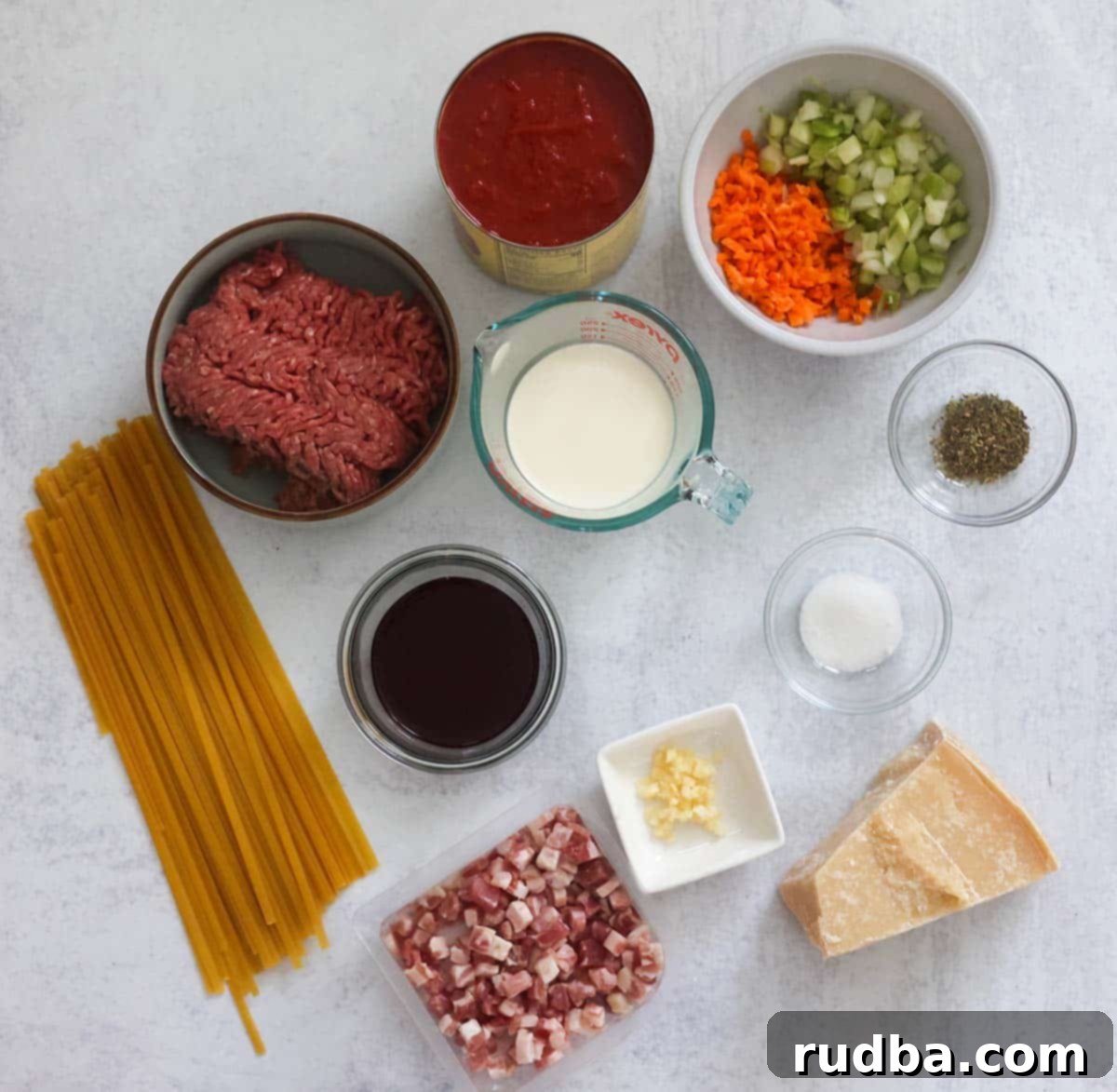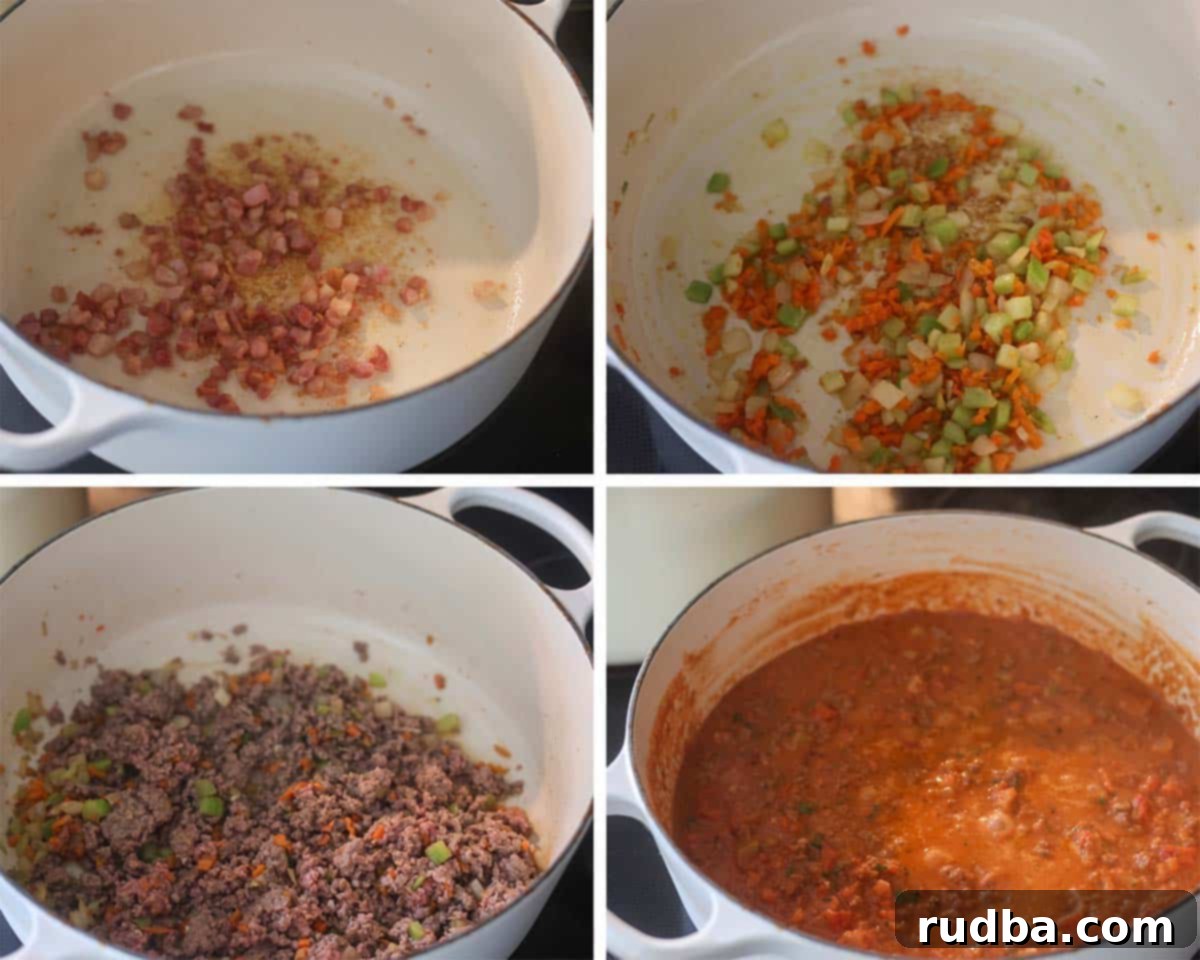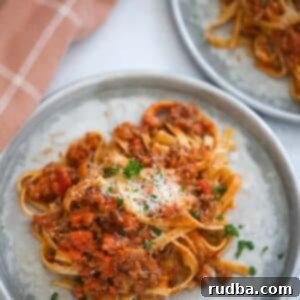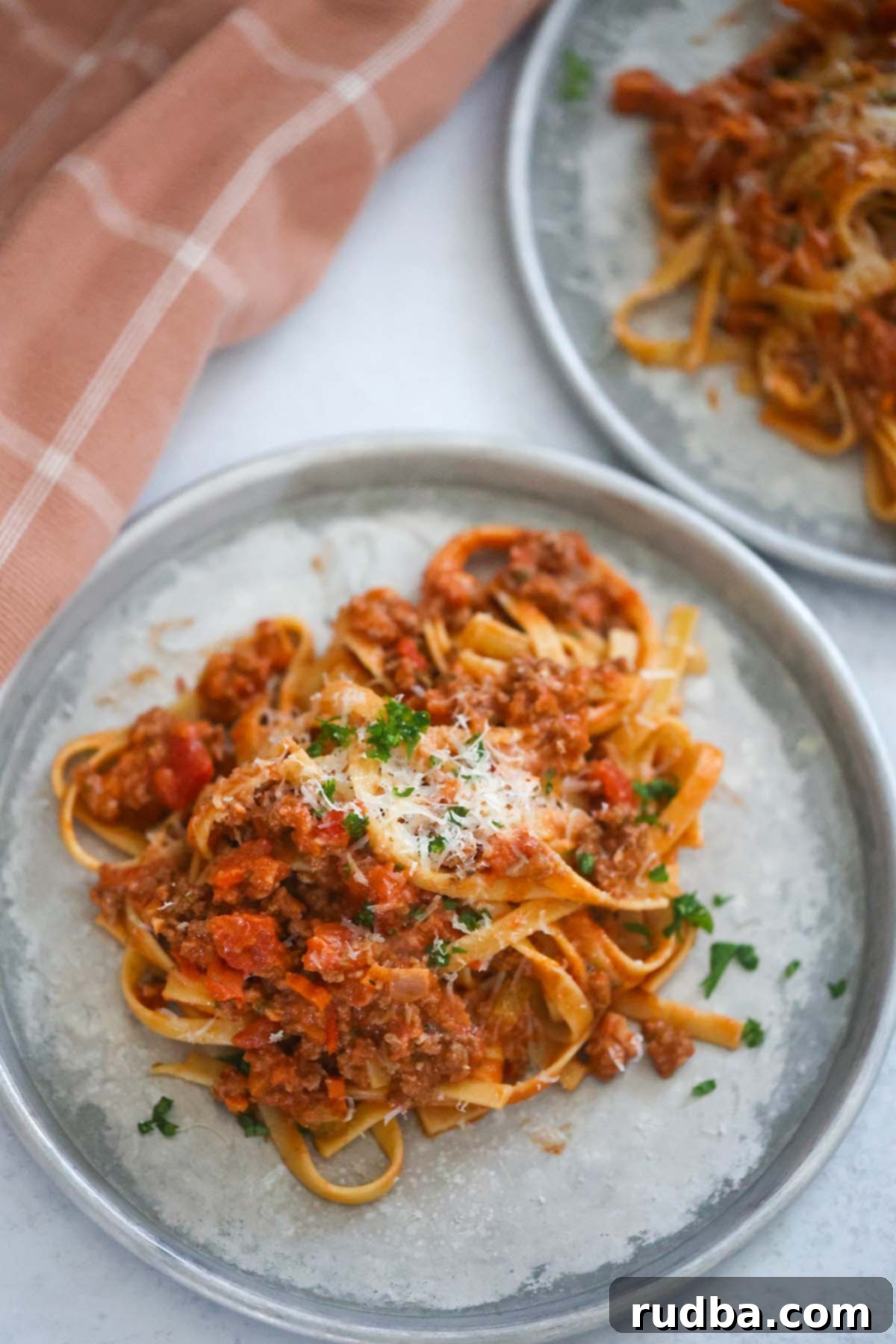Quick & Easy Fettuccine Bolognese: A Rich, Creamy, 45-Minute Weeknight Delight
Craving a deeply flavorful, comforting Italian classic but short on time? This quick and easy Fettuccine Bolognese recipe is your answer! In under 45 minutes, you can create a truly spectacular, rich, and creamy Bolognese sauce that tastes like it simmered for hours. It’s perfect for busy weeknights yet impressive enough for a weekend gathering. Forget endless stirring and long cooking times; this recipe delivers authentic Italian flavors with a convenient twist.
Bolognese is more than just a meat sauce; it’s a culinary hug in a bowl. While traditional versions are known for their slow-cooked, complex layers of flavor, our expedited method doesn’t compromise on taste. By focusing on key ingredients and smart cooking techniques, we achieve that signature velvety texture and robust flavor profile that makes Bolognese so beloved. I love serving this hearty pasta dish with a simple, fresh green salad to cut through the richness and, of course, a generous side of cheesy garlic bread for dipping. However, feel free to pair it with your favorite sides!

The Heart of Bolognese: A Flavorful Journey
Traditionally, a true Bolognese sauce, originating from Bologna in the Emilia-Romagna region of Italy, is a slow-simmered ragù made with a blend of ground beef, pork, and sometimes veal, along with finely diced vegetables (the “soffritto”), milk, wine, and a small amount of tomato. It’s known for its deep, umami-rich flavor and thick, clinging texture. While our recipe simplifies the process for speed, it stays true to the spirit of Bolognese by building incredible flavor through key components: a savory soffritto, high-quality ground beef, and the irresistible crispiness of pancetta.
My personal favorite rendition of this classic swaps the traditional mixed ground meats for a combination of ground beef and crispy pancetta. This not only speeds up the cooking but also infuses the sauce with an unparalleled depth and saltiness that I’ve found utterly addictive. After perfecting this recipe over multiple attempts, I can confidently say this version strikes the perfect balance between speed, simplicity, and genuinely delicious results. It’s a game-changer for anyone who loves rich Italian pasta but doesn’t have hours to spare.
Table of Contents
- INGREDIENT NOTES & SMART SWAPS
- EXPERT TIPS FOR THE BEST BOLOGNESE
- SERVING SUGGESTIONS
- STORAGE & MAKE-AHEAD TIPS
- RECIPE VARIATIONS & CUSTOMIZATIONS
- FREQUENTLY ASKED QUESTIONS
- Fettuccine Bolognese Recipe
INGREDIENT NOTES & SMART SWAPS
To ensure the best results for your homemade Fettuccine Bolognese, pay attention to the quality and preparation of your ingredients. See the full recipe card below for exact quantities and complete step-by-step instructions.
- Ground Beef: While traditional Bolognese often uses a mix of ground pork and beef, this recipe shines with just ground beef, enhanced by the addition of crispy pancetta. For maximum richness and flavor, I recommend using 80/20 ground beef. The higher fat content renders down beautifully, contributing to a more luxurious sauce. If you prefer a leaner option, 90/10 ground beef will also work, though you might need to add a touch more olive oil when cooking the beef to prevent it from drying out.
- Pancetta: This Italian cured pork belly is a game-changer for flavor. Finely dicing it and cooking it until crispy before adding other ingredients releases incredible savory notes and a subtle saltiness into the pot, forming the foundation of our rich sauce. Do not skip this! If pancetta is unavailable, high-quality bacon can be a decent substitute, but render it thoroughly to get that crisp texture and flavorful fat.
- Tomatoes: A 28-ounce can of crushed tomatoes provides the perfect balance of sweetness and acidity for this quick Bolognese. Crushed tomatoes offer a smoother texture than diced, helping create a cohesive sauce. If you only have a jar of marinara sauce, ensure it’s a good quality brand and roughly the same volume (28 ounces). Using less tomato product will result in a drier sauce, so be sure to adjust pasta quantity accordingly or supplement with a little extra beef stock or water.
- Parmesan Cheese: An absolute essential for authentic Italian flavor! Freshly grated Parmesan Reggiano or Grana Padano will always yield superior results compared to pre-grated varieties, offering a sharper, nuttier taste and better melt. Feel free to use as much or as little as your heart desires – I personally go heavy on the Parmesan!
- Veggies (Sofritto): The combination of onions, carrots, and celery, known as “soffritto” in Italian cooking, forms the aromatic base of the sauce. Dicing them finely and uniformly is crucial for even cooking and ensures they melt into the sauce, providing sweetness and depth without being chunky. Don’t rush this step; softening them properly on low heat is key to unlocking their full flavor.
- Garlic & Herbs: Freshly minced garlic, Italian seasoning (a blend of dried herbs like oregano, basil, thyme, and rosemary), fresh basil, and fresh parsley are essential for building the aromatic profile of our Bolognese. The fresh herbs added at the end brighten the entire dish.
- Sugar: A small amount of sugar helps to balance the acidity of the tomatoes, enhancing the overall sweetness and roundness of the sauce. It’s a secret weapon for a perfectly balanced tomato-based sauce.
- Red Wine or Beef Stock: Red wine (a dry red like Chianti or Merlot works best) adds depth and complexity, deglazing the pot and picking up all those flavorful browned bits. If you prefer not to use alcohol, unsalted beef stock is an excellent alternative, providing a savory foundation.
- Heavy Cream: This is what gives our Bolognese its signature creamy, luscious texture and a touch of luxurious richness, perfectly balancing the savory meat and tangy tomatoes.
- Pasta: While this recipe specifies fettuccine, which is excellent for catching the hearty sauce, feel free to use any pasta shape you prefer! Tagliatelle, pappardelle, rigatoni, or even spaghetti are all great choices. Just ensure you cook your pasta al dente – slightly firm to the bite – as it will finish cooking briefly in the sauce.

EXPERT TIPS FOR THE BEST BOLOGNESE
Achieving a restaurant-quality Bolognese at home, even in a shorter timeframe, is entirely possible with these key tips:
- Master the Soffritto: The base of any great Italian sauce starts with a proper soffritto (onions, carrots, celery). Cook these finely diced vegetables in plenty of the rendered pancetta fat (or olive oil if using leaner meat) over low heat for at least 4-5 minutes, until they are truly softened and translucent. This step is crucial for building a deep, sweet, and aromatic foundation before you even think about adding the garlic and ground beef. Don’t rush it!
- Crispy Pancetta First: Always cook the pancetta first until it’s perfectly crispy. This process renders out its fat, which then becomes the flavorful cooking medium for your vegetables and meat. The crispy bits of pancetta can be set aside and stirred back into the sauce at the very end for an extra burst of salty, savory texture. This step significantly elevates the flavor profile of your Bolognese sauce.
- Achieve Perfect Browning: When adding the ground beef, make sure to brown it thoroughly. Break it apart with a spoon and let it cook until all moisture has evaporated and the meat starts to caramelize and brown. This browning (Maillard reaction) develops incredible savory flavors that are essential for a rich Bolognese. Drain any excess fat if necessary, but keep a little for flavor.
- Deglaze with Wine (or Stock): After browning the meat, add the red wine (or beef stock) and scrape the bottom of the pot with a wooden spoon. This releases all the flavorful browned bits (fond) stuck to the bottom, incorporating them back into the sauce and adding immense depth. Allow the liquid to reduce by half, concentrating its flavor.
- Balance the Seasoning: While your meat sauce might taste amazing on its own, plain pasta can dilute its flavor. Always adjust the seasoning *after* you’ve mixed the cooked pasta with the Bolognese sauce. Taste the combined dish and add more salt, freshly ground black pepper, or Parmesan cheese as needed to ensure the entire dish is perfectly balanced and flavorful.
- Mix Thoroughly Before Serving: Meat sauces tend to settle at the bottom of the pot. Before serving, give the entire pot a good, thorough stir to evenly distribute the rich meat sauce and tender pasta throughout the dish, ensuring every bite is perfect.
- Reserve Pasta Water: Before draining your cooked pasta, reserve about a cup of the starchy pasta water. If your sauce seems too thick or needs a little extra creaminess, a splash or two of this starchy water can help emulsify the sauce and create a beautiful, silky texture that clings perfectly to the pasta.

SERVING SUGGESTIONS
While Fettuccine Bolognese is a complete meal on its own, pairing it with complementary sides can elevate your dining experience:
- Garlic Bread or Ciabatta: A must! Crispy, buttery garlic bread or a crusty loaf of ciabatta is perfect for soaking up every last drop of that incredible sauce.
- Fresh Green Salad: A simple, lightly dressed green salad with a vinaigrette provides a refreshing contrast to the richness of the Bolognese.
- Roasted Vegetables: Asparagus, broccoli, or green beans roasted with a little olive oil, garlic, and lemon zest make a healthy and flavorful side.
- Extra Parmesan: Always have extra grated Parmesan cheese on the table for guests to add to their liking.
- A Glass of Red Wine: A medium-bodied red wine like a Sangiovese or a lighter Merlot pairs beautifully with the rich flavors of Bolognese.
STORAGE & MAKE-AHEAD TIPS
Proper storage is key to enjoying your delicious Bolognese leftovers, and knowing how to prepare it ahead of time can be a lifesaver for busy schedules.
- Storing Separately (Recommended for Leftovers): You can either serve the Bolognese sauce directly over the pasta or mix the pasta into the sauce right away. If you’re cooking for 1 or 2 people and anticipate leftovers, I highly recommend storing the sauce in an airtight container separately from the cooked noodles. The sauce maintains its quality and texture much better on its own, and the pasta won’t become mushy or absorb too much liquid. Store the sauce in the refrigerator for up to 3-4 days. Cook fresh pasta just before serving the sauce.
- Storing Combined Pasta and Sauce: If you’ve already mixed the pasta and sauce, simply transfer any leftovers to an airtight container and refrigerate for up to 3 days. Be aware that the pasta will continue to absorb the sauce and may become softer.
- Reheating:
- Stovetop: For best results, gently reheat the sauce (or combined dish) in a pot over medium-low heat, stirring occasionally, until heated through. If the sauce has thickened too much, add a splash of beef stock, water, or even a little milk or cream to loosen it up.
- Microwave: Reheat individual portions in the microwave on medium power, stirring every minute, until warm.
- Freezing the Sauce (Make-Ahead Friendly!): Bolognese sauce freezes exceptionally well! This makes it an ideal meal prep component. Allow the cooked sauce to cool completely, then transfer it to freezer-safe airtight containers or heavy-duty freezer bags. Lay freezer bags flat to save space. Freeze for up to 3 months. Thaw overnight in the refrigerator before reheating on the stovetop.

RECIPE VARIATIONS & CUSTOMIZATIONS
This Fettuccine Bolognese recipe is wonderfully versatile. Feel free to experiment with these variations to suit your taste or dietary needs:
- Mixed Meats: For a more traditional approach, use a blend of ground beef and ground pork (or even veal) in equal parts. This can add another layer of savory depth to the sauce.
- Spicier Kick: Add a pinch of red pepper flakes along with the garlic for a subtle heat, or more for a bolder spice.
- Vegetable Boost: Incorporate finely chopped mushrooms, zucchini, or bell peppers into the soffritto mixture for extra nutrition and flavor.
- Herb Variations: While Italian seasoning is a great base, fresh rosemary or thyme can also be wonderful additions.
- Dairy-Free Option: Omit the heavy cream and Parmesan cheese for a dairy-free version. The sauce will still be incredibly flavorful! You could use a dairy-free cream alternative if desired, but it’s not essential.
- Wine Alternative: If you prefer not to use alcohol, beef stock is a perfectly fine substitute for the red wine. Vegetable stock can also be used for a lighter flavor profile.
- Different Pasta Shapes: While fettuccine is classic, this rich sauce pairs well with any broad, flat pasta like tagliatelle or pappardelle, or even short, tubular pasta like rigatoni or penne that can capture the chunky meat sauce.
FREQUENTLY ASKED QUESTIONS
What is the difference between Bolognese and Marinara?
Bolognese is a rich, slow-cooked Italian meat-based sauce (ragù) that typically includes a soffritto (onions, carrots, celery), various meats, wine, milk or cream, and a relatively small amount of tomatoes. It’s known for its complex, savory, and often creamy texture. Marinara, on the other hand, is a simple, quick-cooking tomato-based sauce, often made with crushed tomatoes, garlic, herbs (like basil and oregano), and olive oil. It’s typically vegetarian and lighter, with a more pronounced tomato flavor.
Can I make this Bolognese ahead of time?
Absolutely! Bolognese sauce is one of those dishes that often tastes even better the next day as the flavors have more time to meld. You can prepare the sauce entirely, cool it, and store it in an airtight container in the refrigerator for up to 3-4 days. When ready to serve, simply reheat the sauce and cook fresh pasta.
Can I freeze Bolognese sauce?
Yes, Bolognese sauce freezes beautifully! Allow the sauce to cool completely, then transfer it to freezer-safe containers or heavy-duty freezer bags. It can be frozen for up to 3 months. Thaw overnight in the refrigerator before reheating gently on the stovetop.
What kind of pasta is best for Bolognese?
Traditionally, Bolognese is served with broad, flat pasta like tagliatelle, pappardelle, or fettuccine, as these shapes are excellent for catching the rich, hearty sauce. However, other shapes like rigatoni or even spaghetti can also work well.
Why add sugar to tomato sauce?
A small amount of sugar helps to balance the natural acidity of the tomatoes, creating a more mellow and well-rounded flavor profile in the sauce. It doesn’t make the sauce overtly sweet, but rather enhances the savory notes and overall balance.
Do I have to use red wine in the recipe?
No, you don’t have to use red wine. While it adds a wonderful depth of flavor, you can easily substitute it with an equal amount of unsalted beef stock (or vegetable stock) for a delicious alcohol-free version.

Fettuccine Bolognese
Equipment
- large pot
Ingredients
- 1 lb ground beef
- 4 ounces pancetta , finely diced
- ¼ cup onions, finely diced
- ¼ cup celery, finely diced
- ¼ cup carrots, finely diced
- 2 garlic cloves, finely minced
- 1 teaspoon Italian seasoning
- 1 teaspoon sugar
- 28 ounces crushed tomatoes
- ¼ cup red wine , or beef stock
- ¼ cup heavy cream
- 1 teaspoon parsley , fresh
- 1 teaspoon basil , fresh
- 1 lb fettuccine, cooked til al dente
- parmesan cheese , to taste
- salt and pepper , to taste
Instructions
- Add the pancetta to a large pot and cook over medium heat for 4-5 minutes or until crisp. Once the pancetta is nice and crisp, remove it from the pot and set it aside. Leave the grease that the pancetta releases in the pot.
- Add the onions, carrots, and celery to the pot and cook for 4-5 minutes or until softened. Add oil if needed.
- Stir in the garlic and cook for 15 seconds. Add the beef, breaking it apart as it cooks, and continue until the beef is fully browned, about 5-6 minutes.
- Add the red wine and cook for 2-3 minutes or until the wine reduces by half.
- Stir in the crushed tomatoes, sugar, Italian seasoning, and season generously with salt and pepper. Once the meat sauce comes to a simmer, cover and cook for 15 minutes over medium heat.
- Once the 15 minutes are up, add the heavy cream, fresh basil, fresh parsley, and allow it to cook for 1-2 minutes.
- Add the cooked pasta and parmesan cheese, check for seasoning, and add more salt and pepper if needed.
- Serve warm, and enjoy!
Notes
- Cook the onions, carrots, and celery (called the sofrito) in plenty of oil on low heat for at least 4-5 minutes to soften the veggies, before adding the garlic and ground beef!
- Cook the pancetta first until it’s crispy. This will add a lot of flavor and saltiness to your bolognese sauce. I highly recommend adding it!
- After mixing the cooked pasta with the meat sauce, check the seasoning before serving. The sauce may taste great, but the plain noodles can make the whole dish taste bland. Always adjust the seasoning at the end, adding more salt or cheese if needed.
Nutrition
Nutrition information is automatically calculated, so should only be used as an approximation.
Additional Info
If you’ve tried this fantastic Fettuccine Bolognese recipe and loved it, please don’t hesitate to leave a star ⭐️⭐️⭐️⭐️⭐️ rating in the recipe card above and/or a review in the comments section further down the page. Your feedback is invaluable! And for more delicious, easy-to-make recipes, consider following me on Facebook or Pinterest!
